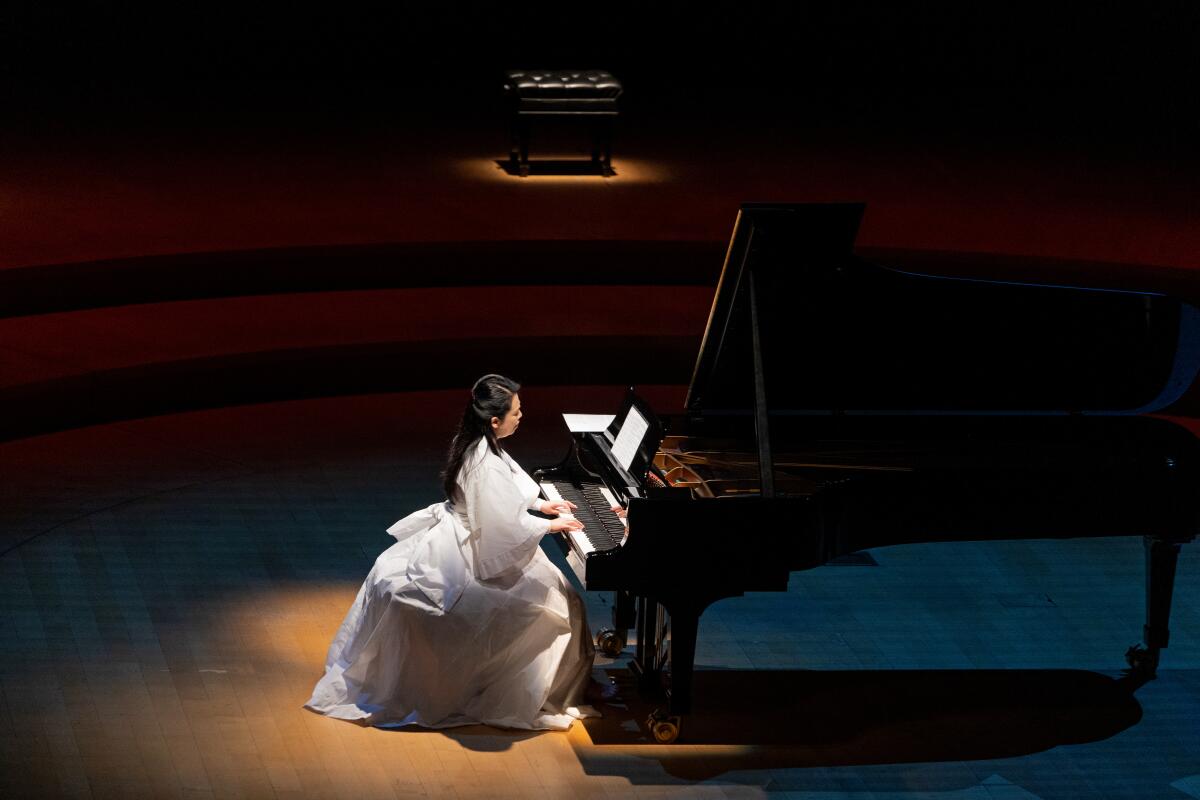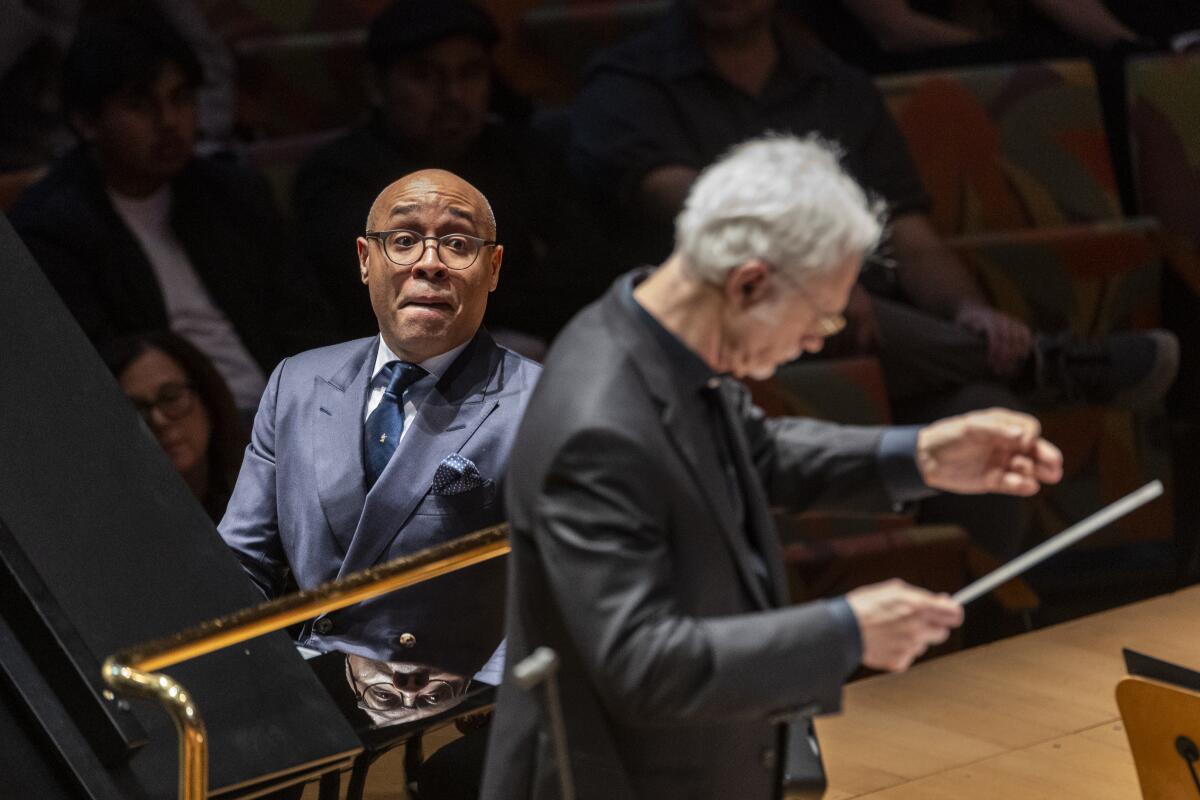There’s no escaping Philip Glass and his piano etudes right now

- Share via
In 1994, Philip Glass wrote six seemingly ordinary piano etudes for conductor and pianist Dennis Russell Davies on the occasion of his 50th birthday. Glass also wrote them for himself. Etudes are traditionally studies in technique, and here they’re an ever-pragmatic composer’s exercises to improve his own playing.
Davies gave the premiere in Bonn, Germany, in 1994 and soon after played them at the Brooklyn Academy of Music. They seemed then like both technical studies and compositional ones, focusing on this melodic cell or that propulsive rhythmic idea, meant to get the fingers going and the compositional juices flowing, but not much more than that.
With Glass, however, you never know where anything will wind up. He may start out in overly familiar territory, then through barely perceptible gradual changes the end point becomes an unexpected marvel. That the grain of the marvel was always there is sensed only in retrospect.
Something similar happened with the composition of the etudes themselves. Over a span of two decades, Glass wrote two books of 10 each, becoming ever more richly lavish and virtuosic beyond the composer’s own piano skills. The solemn and gorgeous 20th is a Glass masterpiece that abstractly mirrors the music to Godfrey Reggio’s 2013 film “Visitors,” a series of small portraits that, with the help of Glass’ score, becomes a kind of cinematic transmigration of their souls.
The full 20 etudes are now essential Glass, his most performed music. There have been at least a dozen complete recordings, the latest by the eloquent Polish pianist Maciej Ganski, released March 25. They have become encore favorites by noted pianists. Yuja Wang turns No. 6 into a stunning showpiece. Choreographers as well as pianists (professional and amateur alike) can’t get enough of them.
A lovingly produced large box, with sheet music of each etude and a book of eclectic essays about the etudes, came out late last year. Among those who pay the etudes tribute in it are chef Alice Waters, painter Jenny Saville, choreographers Justin Peck and Lucinda Childs, film director Martin Scorsese, performance artist Laurie Anderson, writer Pico Iyer and NPR newscaster Ari Shapiro.
The 20 etudes have also been part of a touring in a production by Pomegranate Arts over the past decade. The cycle finally reached L.A. last month presented by the Los Angeles Philharmonic as a Green Umbrella concert.
It was a revelation, but not so much for what it told us about the etudes, although there was that, but about what Glass has wrought on music in general. Acceptance of the 87-year-old composer by the classical music establishment has been painfully slow and weirdly irregular. On same day of the etudes event at Walt Disney Concert Hall, the New York Philharmonic announced that its 2024-25 season includes Gustavo Dudamel conducting Glass’ Symphony No. 11. Shockingly, it will be the first time the orchestra will play a Glass symphony (he’s up to 14) and only its second time performing a concert work by New York’s most famous composer since Leonard Bernstein.
Over the 10 days following the etudes at Disney, at concert after concert in the hall and around town, on international radio and on recording, there was proof that — whether you love him, hate him, pay him or his music no mind, or pretend he doesn’t matter — you cannot escape Philip Glass. His impact on composers of succeeding generations, whether they accept him or oppose him, is indelible.
The weekend of concerts by the San Francisco Symphony, L.A. Phil and Colburn Orchestra at Disney following the etudes featured three central post-Glass generations of composers and performers — John Adams, Esa-Pekka Salonen and Timo Andres — all of whom have been affected one way or another by Glass. Their music may not sound anything like Glass (in Salonen’s case adamantly not), but none of it would have been the same without Glass’ precedent.
In this Adams is a central figure. As the longtime L.A. Phil creative chair, he programs the Green Umbrella series, and it was significant that Glass preludes preceded a weekend devoted to Adams and his influence at Disney. Much of Glass’ own influence on American classical music has been channeled through Adams. It was he who found a way to apply the hardcore outsider minimalist musical revolution of Glass, Steve Reich and Terry Riley to a more inclusive and original musical language. With startling originality, Adams combined the propulsive energy of Glass to his more mainstream musical enthusiasms, be they Sibelius symphonies, late Beethoven string quartets, Stravinsky, American jazz and much else.
At Disney, Salonen, touring with his San Francisco Symphony, led an arresting performance of Adams’ “Naïve and Sentimental Music,” a grand symphony in all but name, of which Salonen had given the world premiere with the L.A. Phil in 1999. No Glass is audible in this vast sonic landscape, but its propulsion has minimalist roots and in the exquisite quiet center of its slow movement there is a kind of Glassian sentience. The reception on this occasion was almost like a rock concert from a cheering, screaming audience. The players, too, applauded Salonen and stamped their feet, showing support for their music director, who has announced that he will not renew his contract as music director because of the lack of support from the orchestra’s board.
Not only had Glass helped to pave the way for Adams, but it was Adams who helped pave the way for Salonen as a composer. As far as I know, the only time Salonen has ever performed Glass was dressed in a bunny suit in a moment of silliness at the 1999 Ojai Music Festival. He and composer Magnus Lindberg began an opera-themed Saturday morning children’s concert seated at a piano as bunnies, banging out the opening of “Einstein on the Beach.” That evening, Salonen conducted Adams’ Chamber Symphony, in which Glass and a few other composers irreverently meet Schoenberg.
It was Adams and particularly the Chamber Symphony that had led to Salonen’s own compositional breakthrough with “LA Variations” two years earlier, not so much as a style (no Glass, for sure) but as permission to allow new uses of melody and harmony in his music.
Adams was just back in town after the London premiere of his latest wild and wildly engaging symphonic score, “Frenzy,” conducted by Simon Rattle with the London Symphony. (An L.A. Phil co-commission, it is supposed to arrive here in the 2025-26 season but can be heard through April 24 in an archived broadcast on BBC Radio 3.) At Adams’ concert conducting the L.A. Phil last month, he turned to yet another of his large symphonic works, “City Noir,” this one commissioned for Dudamel in 2009. In a performance both moody and propulsive, Adams relished his echoes of jazz and classic soundtracks from 1950 Hollywood noir soundtracks.

He also conducted a premiere by his younger colleague, Timo Andres, who is a superb pianist and happened to be one of the five participants in the etudes concert. “Made of Tunes,” though, is a concerto for Aaron Diehl, a pianist equally conversant in classical music and jazz, and someone with his own attachment to Glass: He made a sparkling jazz trio arrangement of No. 16. The “tunes” Andres makes use of in his concerto come from American folk songs, parlor songs, blues and ragtime, and they go through colorful repetitive transformations, embellished by Diehl’s improvisations. While sounding little of Glass or Adams, the way Andres develops his tunes as process, his arresting use of percussion and the music’s forward motion all imply that he has absorbed Glass and Adams into his own unique voice.
That originality was very much on display in the etudes marathon itself. Along with Andres’ brilliantly illuminating performances, Maki Namekawa, who has been muse to Glass, brought her radiance to all she touched, especially No. 20. Jenny Lin made sure we heard the etudes as brilliantly virtuosic new music. Russian pianist Anton Batagov made sure we heard them as brilliantly hypnotizing traditional music. Crossover pianist Lara Downes could have you believe the etudes were written in 2024.
In the book of short essays about the etudes, Davies, who has conducted nearly all of Glass’ operas and symphonies and who is married to Namekawa, contends that the challenge of the etudes is to keep them pure, “in the sense of keeping the ego out of it.” When his wife was learning them, he writes, he had to go outside to leave her alone.
He has a point. Letting the processes in Glass’ music speak for themselves is what gives license for others, including Glass dissenters such as Salonen, to find their own processes. But when it comes to interpreting the etudes, which Davies fears could be overly romanticized in the wrong hands, he’s going to need to spend a lot of time outside.
The week following the Disney cycle, the second and fifth etudes got a complete makeover in UCLA’s Center for the Art of Performance’s “Maya Beiser X Philip Glass in Concert” at the Nimoy. The cellist, joined by four cello colleagues, slowed the etudes down to almost half speed, wrapping and enrapturing her surroundings with the sonic blanket of amplified cellos. These transcriptions were no longer piano etudes, per se, but the performances conveyed the essence of practicing, of learning a piece by slowly going over and over passages, getting more and more inside the sound of your instrument.
The resonance of Glass’ openness in the etudes is, indeed, inescapable. Laurie Anderson and the composer Jlin both write of Glass creating a sense of the infinite. Closer at hand, Third Coast Percussion includes Glass and Jlin in its concert at the Nimoy on Friday. Works by Anderson and Jlin will be part of the the Kronos Quartet’s program at Royce Hall on April 28.
More to Read
The biggest entertainment stories
Get our big stories about Hollywood, film, television, music, arts, culture and more right in your inbox as soon as they publish.
You may occasionally receive promotional content from the Los Angeles Times.











